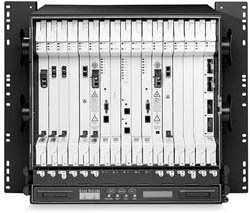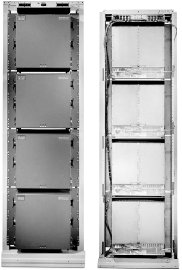Chapter 1. Market Drivers for Multiservice Provisioning Platforms
Multiservice Provisioning Platforms (MSPPs) are optical platforms into which you can insert or remove various ring and service cards. The interfaces on these cards deliver a variety of electrical and optical services, such as traditional time-division multiplexed (TDM) circuit-based and packet-based data services within the chassis. Because they are modular, MSPPs enable you to insert cards such as plug-ins or blades. This modularity accommodates the aggregation of traditional facilities such as DS1, DS3, STS1, OC-3, STM1, OC-12, STM4, OC-48, and STM64. MSPPs also support current data services such as 10-Mb Ethernet, 100-Mb Ethernet, and Gigabit Ethernet (GigE). Emerging storage-area networking (SAN) services such as Fiber Connection (FICON), Fibre Channel (FC), and Enterprise Systems Connection (ESCON) can also be aggregated via STS-1, STS-3c, STS-6c, STS-9c, STS12-c, STS-24c, or STS-48c interfaces; these services can be transported over a single optical transport facility via an OC-3, OC-12, OC-48, OC-48 DWDM, OC-192, or OC-192 DWDM line interface. The service cards have multiple ports or connections per card. For example, a lower-density electrical DS1 card can drop out 14 DS1s, and higher-density cards can drop out up to 56 DS1s. This is true for all other service cards as well. The platform flexibility translates into drastically improved efficiencies in the transport layer and dramatically increased savings in both the initial costs and the life-cycle costs of the deployment. Some of the latest technology in MSPP integrates dense wavelength-division multiplexing (DWDM) into the chassis and can deliver wavelengths of various types. The footprint is typically one quarter of a 19-inch or 23-inch standard rack or bay in size. Figure 1-1 shows an MSPP, and Figure 1-2 shows multiple MSPPs deployed in a single bay. Figure 1-1. An MSPP Figure 1-2. Standard 19-Inch Bay with Four MSPPs MSPPs are in use today by every major incumbent local exchange carrier (ILEC) and competitive local exchange carrier (CLEC), most independent carriers, and cable companies and large enterprise customers that utilize these MSPPs over leased fiber. Figure 1-3 shows a carrier (such as a service provider) deployment of MSPP to deliver services to multiple customers. Figure 1-4 shows a customer's private implementation over leased fiber. Figure 1-5 shows a CLEC implementation that uses the ILEC's network and delivers services to the customers. Figure 1-3. Service Provider Network Implementation of MSPP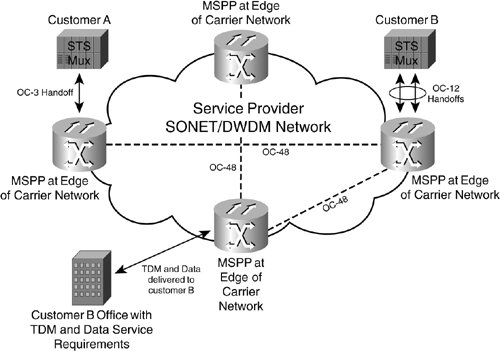 Figure 1-4. Customer Private Network Implementation of MSPP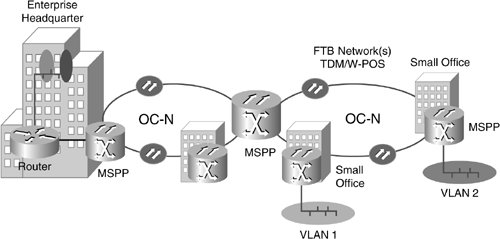 Figure 1-5. CLEC-to-ILEC Network Implementation of MSPP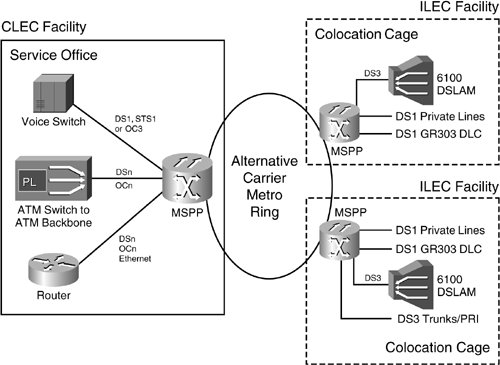 The emergence of MSPP in the late 1990s enabled CLECs to take advantage of regulatory changes that essentially forced incumbents to "unbundle" their networks. In other words, incumbents had to allow competitors to lease their network infrastructure. CLECs could very quickly and inexpensively establish a non-asset-based network because the ILEC owned the entire network infrastructure, except for the customer access MSPP shelf of the CLEC. CLECs then begin to sell services off the MSPP rapidly because they were not encumbered with legacy operating support systems (OSS). Figure 1-5 shows an example of this non-asset-based network. This also enabled CLECs to add network assets in proportion to revenue flow and thus grow their own asset-based network. They were able to wean themselves off the ILEC networks to become standalone asset-based CLECs. |
EAN: 2147483647
Pages: 140
